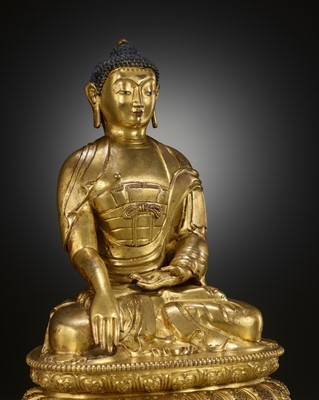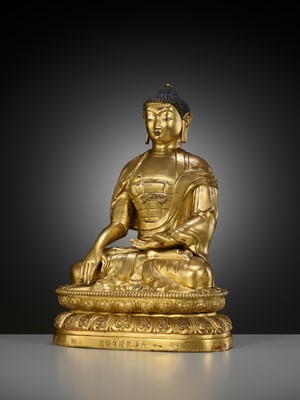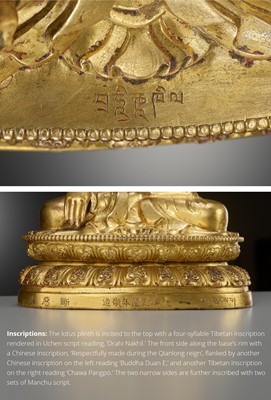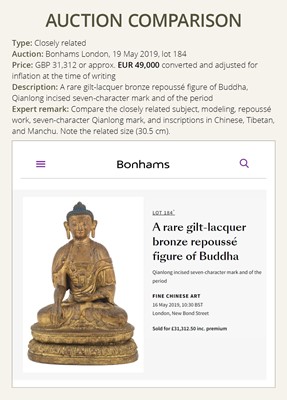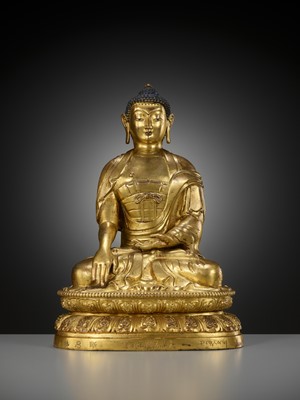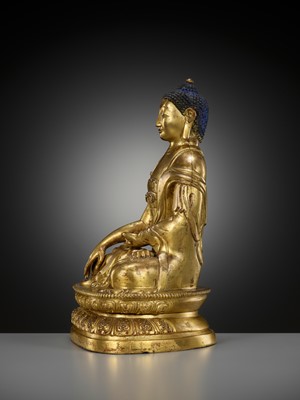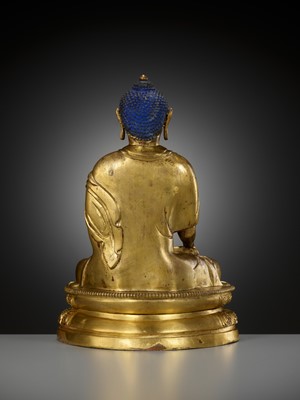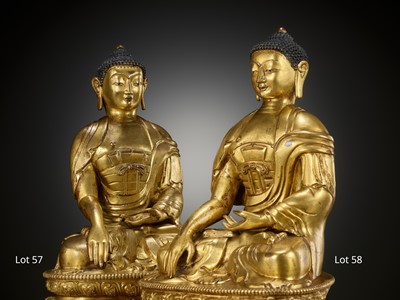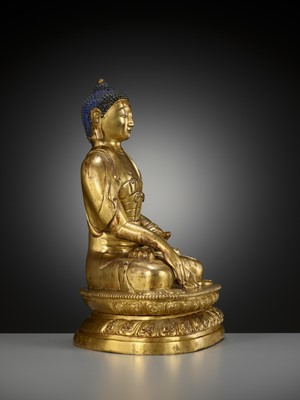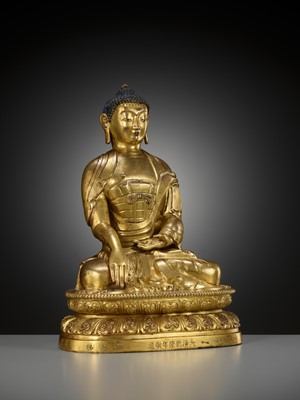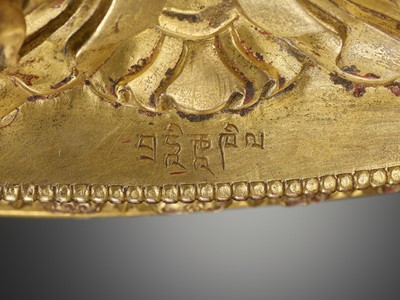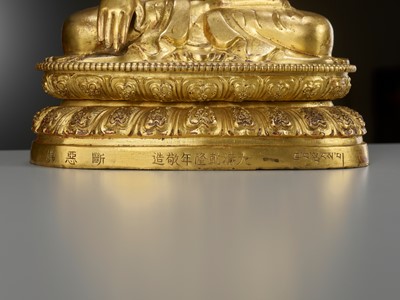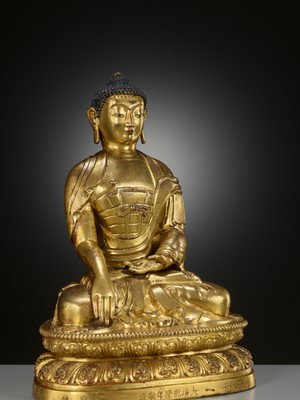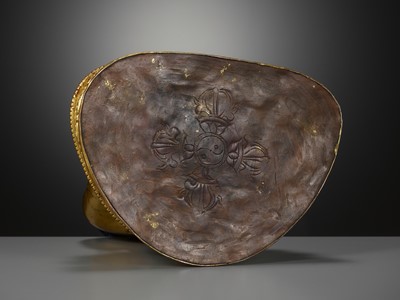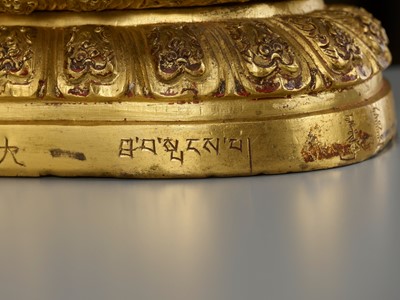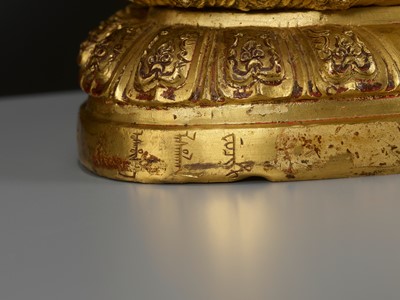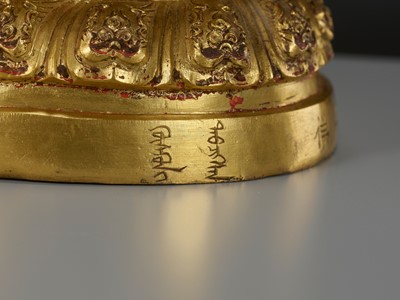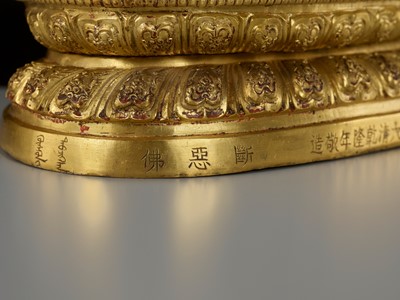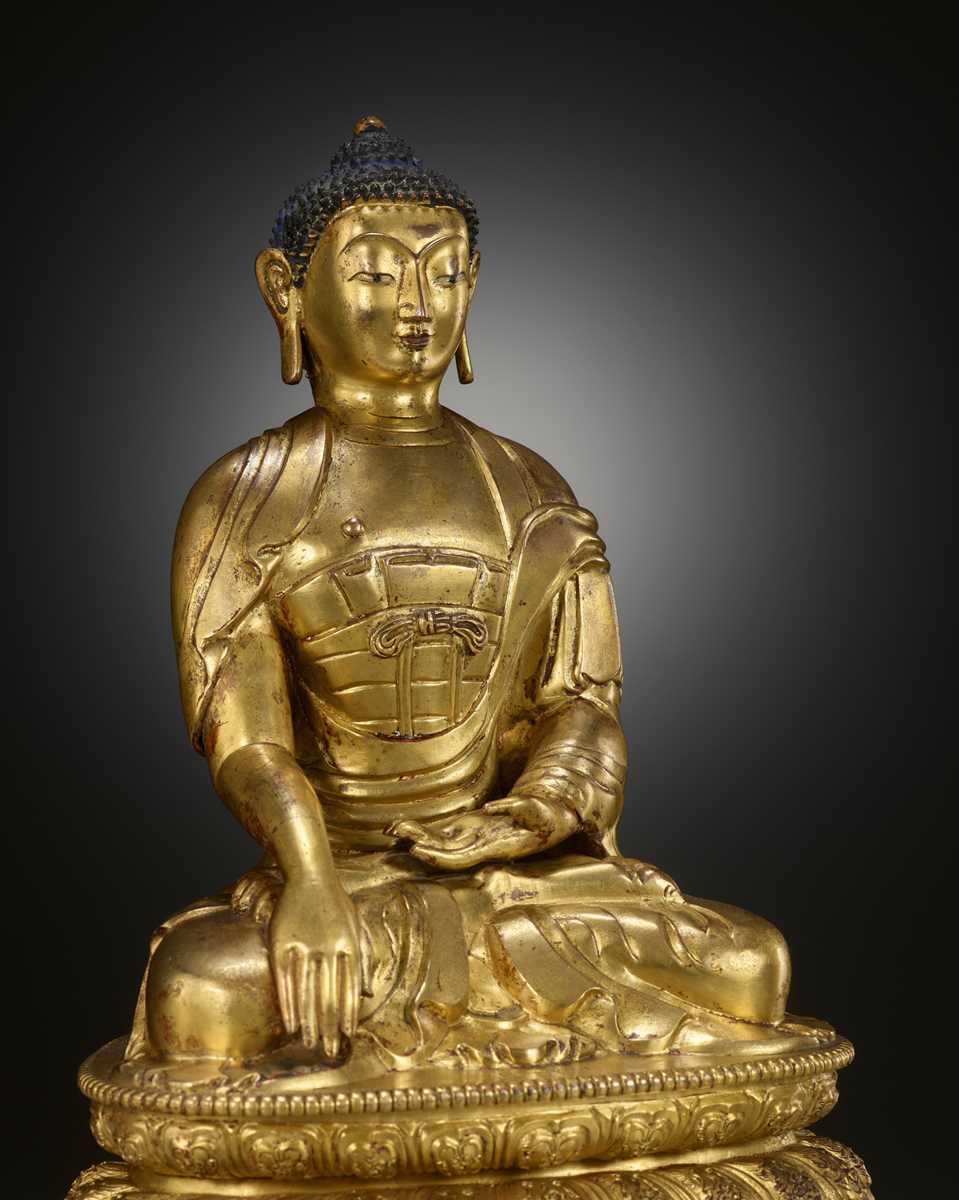11th Apr, 2024 11:00
TWO-DAY AUCTION: Fine Asian Art, Buddhism and Hinduism
57
A GILT-BRONZE REPOUSSÉ FIGURE OF BUDDHA DUAN E, QIANLONG INCISED SEVEN-CHARACTER MARK AND PERIOD
Sold for €89,320
including Buyer's Premium
China, 1736-1795. Well modeled seated in dhyanasana atop a double-lotus pedestal with a beaded rim, his right hand lowered in bhumisparsa mudra, the left held above his lap. His long robes open at the chest, tied at the midriff, with a shawl draped over both shoulders. His serene face with downcast gaze, sinuous eyelids, and bow-shaped lips forming a calm smile, flanked by long pendulous earlobes. His hair arranged in tight curls over the domed ushnisha topped by a jewel. The sealplate incised with a double vajra. The front edge of the base incised with a central seven-character mark da Qing Qianlong nian jingzao and of the period.
Inscriptions: The lotus plinth is incised to the top with a four-syllable Tibetan inscription rendered in Uchen script reading, ‘Drahi Nakhil.’ The front side along the base’s rim with a Chinese inscription, ‘Respectfully made during the Qianlong reign’, flanked by another Chinese inscription on the left reading ‘Buddha Duan E,’ and another Tibetan inscription on the right reading ‘Chawa Pangpo.’ The two narrow sides are further inscribed with two sets of Manchu script.
Provenance: Swiss trade. Acquired from a private estate, where it had been in the family for a long time.
Condition: Very good condition with minor wear, manufacturing irregularities, small nicks, minor dents, little rubbing to gilt, remnants of pigment. The base sealed.
Weight: 2,480 g
Dimensions: Height 31.2 cm
The epithet Buddha Duan E (literally ‘Breaker of Evil Buddha’) likely refers to the Buddha’s teaching on the ultimate destruction of evil at the end of the world in the Sattasuriya sutta (Sermon of the Seven Suns), in the Anguttara Niksya [AN 7.66] of the Pali Canon, according to which, ‘All things are impermanent, all aspects of existence are unstable and non-eternal. Beings will become so weary and disgusted with the constituent things that they will seek emancipation from them more quickly. There will come a season, O monks, when after hundreds of thousands of years, rains will cease. All seedlings, all vegetation, all plants, grasses and trees will dry up and cease to be...There comes another season after a great lapse of time when a second sun will appear. Now all brooks and ponds will dry up, vanish, cease to be.’ The canon goes on to describe the progressive destruction of each sun. A third sun will dry the mighty Ganges and other great rivers. A fourth will cause the great lakes to evaporate, and a fifth will dry the oceans. Eventually, the final suns will appear: ‘Again after a vast period of time a sixth sun will appear, and it will bake the Earth even as a pot is baked by a potter. All the mountains will reek and send up clouds of smoke. After another great interval a seventh sun will appear and the Earth will blaze with fire until it becomes one mass of flame. The mountains will be consumed, a spark will be carried on the wind and go to the worlds of God....Thus, monks, all things will burn, perish and exist no more except those who have seen the path.’
The polyglot inscriptions on the present lot are perhaps indicative of the role that Vajrayana Buddhism played for the court in consolidating control over the Han, Manchu, Mongol, and Tibetan subjects of the Qing realm. In addition, the specific identification of this figure belies an emphasis on iconographic accuracy that was of paramount importance to the Qianlong Emperor. Patricia Berger discusses both of these issues at length in her Empire of Emptiness: Buddhist Art and Political Authority in Qing China, 2003, passim.
Auction result comparison:
Type: Closely related
Auction: Bonhams London, 19 May 2019, lot 184
Price: GBP 31,312 or approx. EUR 49,000 converted and adjusted for inflation at the time of writing
Description: A rare gilt-lacquer bronze repoussé figure of Buddha, Qianlong incised seven-character mark and of the period
Expert remark: Compare the closely related subject, modeling, repoussé work, seven-character Qianlong mark, and inscriptions in Chinese, Tibetan, and Manchu. Note the related size (30.5 cm).
#byimperialcommand
China, 1736-1795. Well modeled seated in dhyanasana atop a double-lotus pedestal with a beaded rim, his right hand lowered in bhumisparsa mudra, the left held above his lap. His long robes open at the chest, tied at the midriff, with a shawl draped over both shoulders. His serene face with downcast gaze, sinuous eyelids, and bow-shaped lips forming a calm smile, flanked by long pendulous earlobes. His hair arranged in tight curls over the domed ushnisha topped by a jewel. The sealplate incised with a double vajra. The front edge of the base incised with a central seven-character mark da Qing Qianlong nian jingzao and of the period.
Inscriptions: The lotus plinth is incised to the top with a four-syllable Tibetan inscription rendered in Uchen script reading, ‘Drahi Nakhil.’ The front side along the base’s rim with a Chinese inscription, ‘Respectfully made during the Qianlong reign’, flanked by another Chinese inscription on the left reading ‘Buddha Duan E,’ and another Tibetan inscription on the right reading ‘Chawa Pangpo.’ The two narrow sides are further inscribed with two sets of Manchu script.
Provenance: Swiss trade. Acquired from a private estate, where it had been in the family for a long time.
Condition: Very good condition with minor wear, manufacturing irregularities, small nicks, minor dents, little rubbing to gilt, remnants of pigment. The base sealed.
Weight: 2,480 g
Dimensions: Height 31.2 cm
The epithet Buddha Duan E (literally ‘Breaker of Evil Buddha’) likely refers to the Buddha’s teaching on the ultimate destruction of evil at the end of the world in the Sattasuriya sutta (Sermon of the Seven Suns), in the Anguttara Niksya [AN 7.66] of the Pali Canon, according to which, ‘All things are impermanent, all aspects of existence are unstable and non-eternal. Beings will become so weary and disgusted with the constituent things that they will seek emancipation from them more quickly. There will come a season, O monks, when after hundreds of thousands of years, rains will cease. All seedlings, all vegetation, all plants, grasses and trees will dry up and cease to be...There comes another season after a great lapse of time when a second sun will appear. Now all brooks and ponds will dry up, vanish, cease to be.’ The canon goes on to describe the progressive destruction of each sun. A third sun will dry the mighty Ganges and other great rivers. A fourth will cause the great lakes to evaporate, and a fifth will dry the oceans. Eventually, the final suns will appear: ‘Again after a vast period of time a sixth sun will appear, and it will bake the Earth even as a pot is baked by a potter. All the mountains will reek and send up clouds of smoke. After another great interval a seventh sun will appear and the Earth will blaze with fire until it becomes one mass of flame. The mountains will be consumed, a spark will be carried on the wind and go to the worlds of God....Thus, monks, all things will burn, perish and exist no more except those who have seen the path.’
The polyglot inscriptions on the present lot are perhaps indicative of the role that Vajrayana Buddhism played for the court in consolidating control over the Han, Manchu, Mongol, and Tibetan subjects of the Qing realm. In addition, the specific identification of this figure belies an emphasis on iconographic accuracy that was of paramount importance to the Qianlong Emperor. Patricia Berger discusses both of these issues at length in her Empire of Emptiness: Buddhist Art and Political Authority in Qing China, 2003, passim.
Auction result comparison:
Type: Closely related
Auction: Bonhams London, 19 May 2019, lot 184
Price: GBP 31,312 or approx. EUR 49,000 converted and adjusted for inflation at the time of writing
Description: A rare gilt-lacquer bronze repoussé figure of Buddha, Qianlong incised seven-character mark and of the period
Expert remark: Compare the closely related subject, modeling, repoussé work, seven-character Qianlong mark, and inscriptions in Chinese, Tibetan, and Manchu. Note the related size (30.5 cm).
#byimperialcommand
Zacke Live Online Bidding
Our online bidding platform makes it easier than ever to bid in our auctions! When you bid through our website, you can take advantage of our premium buyer's terms without incurring any additional online bidding surcharges.
To bid live online, you'll need to create an online account. Once your account is created and your identity is verified, you can register to bid in an auction up to 12 hours before the auction begins.
Intended Spend and Bid Limits
When you register to bid in an online auction, you will need to share your intended maximum spending budget for the auction. We will then review your intended spend and set a bid limit for you. Once you have pre-registered for a live online auction, you can see your intended spend and bid limit by going to 'Account Settings' and clicking on 'Live Bidding Registrations'.
Your bid limit will be the maximum amount you can bid during the auction. Your bid limit is for the hammer price and is not affected by the buyer’s premium and VAT. For example, if you have a bid limit of €1,000 and place two winning bids for €300 and €200, then you will only be able to bid €500 for the rest of the auction. If you try to place a bid that is higher than €500, you will not be able to do so.
Online Absentee and Telephone Bids
You can now leave absentee and telephone bids on our website!
Absentee Bidding
Once you've created an account and your identity is verified, you can leave your absentee bid directly on the lot page. We will contact you when your bids have been confirmed.
Telephone Bidding
Once you've created an account and your identity is verified, you can leave telephone bids online. We will contact you when your bids have been confirmed.
Classic Absentee and Telephone Bidding Form
You can still submit absentee and telephone bids by email or fax if you prefer. Simply fill out the Absentee Bidding/Telephone bidding form and return it to us by email at office@zacke.at or by fax at +43 (1) 532 04 52 20. You can download the PDF from our Upcoming Auctions page.
How-To Guides
How to Create Your Personal Zacke Account
How to Register to Bid on Zacke Live
How to Leave Absentee Bids Online
How to Leave Telephone Bids Online
中文版本的操作指南
创建新账号
注册Zacke Live在线直播竞拍(免平台费)
缺席投标和电话投标
Third-Party Bidding
We partner with best-in-class third-party partners to make it easy for you to bid online in the channel of your choice. Please note that if you bid with one of our third-party online partners, then there will be a live bidding surcharge on top of your final purchase price. You can find all of our fees here. Here's a full list of our third-party partners:
- 51 Bid Live
- EpaiLive
- ArtFoxLive
- Invaluable
- LiveAuctioneers
- the-saleroom
- lot-tissimo
- Drouot
Please note that we place different auctions on different platforms. For example, in general, we only place Chinese art auctions on 51 Bid Live.
Bidding in Person
You must register to bid in person and will be assigned a paddle at the auction. Please contact us at office@zacke.at or +43 (1) 532 04 52 for the latest local health and safety guidelines.
